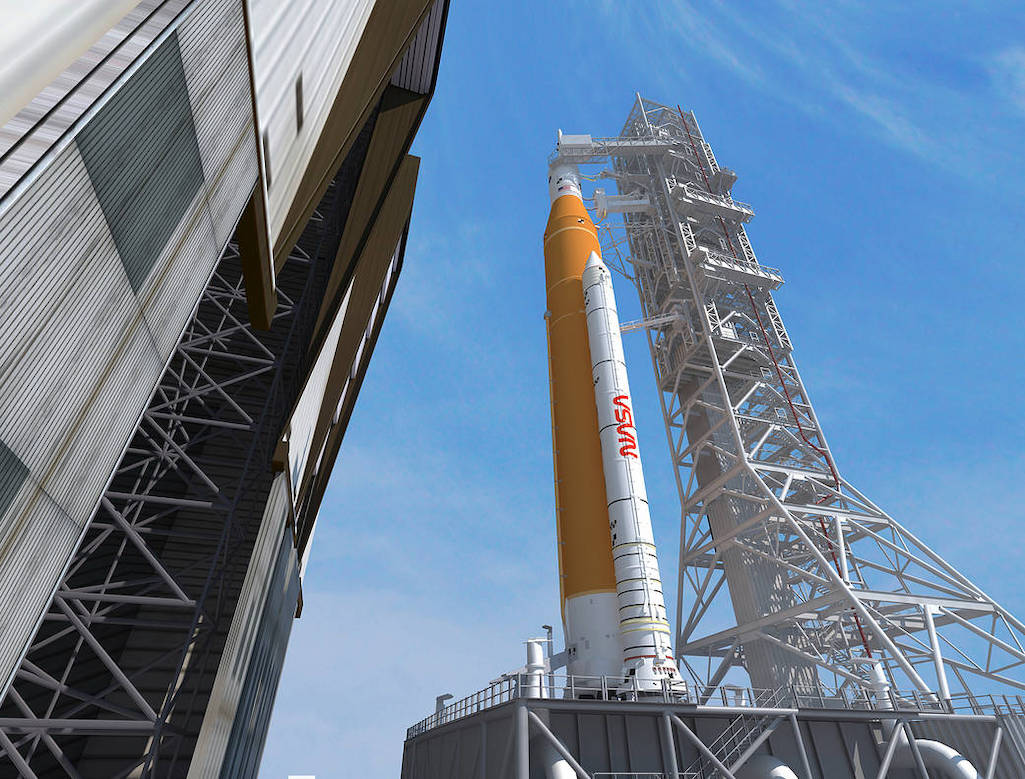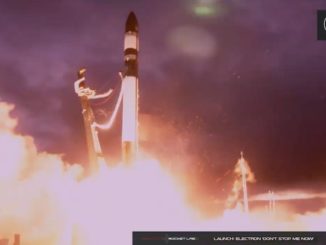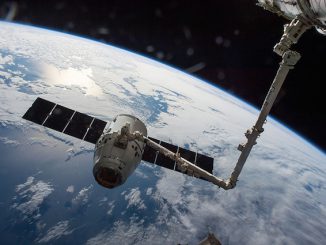
The core of NASA’s first huge Space Launch System heavy-lift rocket designed to carry astronauts back to the moon aced a crucial test-firing Thursday in Mississippi, clearing the way for shipment to Florida for launch preparations.
The 212-foot-tall (65-meter) Boeing-built core stage functioned as designed during the test-firing at the Stennis Space Center in Mississippi, two months after a previous hot fire test prematurely ended a minute after ignition.
“Everything we’ve seen in the test today looked nominal, so I would say that the core stage got an A-plus today,” said John Honeycutt, the SLS program manager at NASA’s Marshall Space Flight Center in Huntsville, Alabama.
The test paves the way for NASA to transport SLS core stage to Florida for preparations for its first launch, which will send an unpiloted Orion capsule on a mission to orbit the moon and return to Earth. SLS/Orion missions will carry astronauts to the moon on NASA’s Artemis program.
The four Aerojet Rocketdyne RS-25 main engines flashed to life at 4:37 p.m. EDT (3:37 p.m. CDT; 2037 GMT) Thursday on the B-2 test stand at Stennis, the same towering facility once used to test-fire Saturn 5 moon rockets during the Apollo program.
Ramping up to full power — equivalent to a 109% throttle setting — the engines generated more than 1.6 million pounds of thrust as a plume of steam exhaust climbed high above the space center in southern Mississippi.
The engines throttled down to a 95% power setting about a minute into the test, following a thrust profile they will use during a real flight to ease the rocket’s flight through the dense, lower regions of the atmosphere.
Ignition! The Space Launch System’s four RS-25 engines have fired up on the test stand at the Stennis Space Center in Mississippi. https://t.co/sfEvLd2eez pic.twitter.com/3SNgpzA2Wl
— Spaceflight Now (@SpaceflightNow) March 18, 2021
Now more than four minutes into the test-firing.
The four RS-25 engines at the base of the SLS core stage completed their first gimbal profile about a minute after ignition.https://t.co/sfEvLd2eez pic.twitter.com/HvB4k8CAk9
— Spaceflight Now (@SpaceflightNow) March 18, 2021
The core stage hydraulic power units engaged to vigorously pivot, or gimbal, the engines faster than they will likely ever have to move during a real launch. The exercise was intended to ensure the rocket can handle intense steering inputs.
The engines kept firing for 499.6 seconds, more than eight minutes, draining more than 733,000 gallons of cryogenic liquid hydrogen and liquid oxygen from the rocket’s propellant tanks, enough to fill 63 large tanker trucks. John Shannon, Boeing’s SLS program manager, said the test-firing achieved all its primary and secondary objectives.
NASA officials were elated with the test, the most significant milestone yet in the nearly 10-year-old SLS program.
A small fire at the base of the rocket noted in live video of the test-firing was expected going into the hot fire, NASA officials said. The super-heated 6,000-degree Fahrenheit exhaust of the RS-25 engines burned some of the cork thermal insulation and tape covering the bottom of the rocket.
“We don’t expect to see that during flight, just due to the environments (being) different, and the aft end of the vehicle won’t experience that same radiative heat load,” Honeycutt said.
Engine shutdown!
The SLS core stage has completed a 500-second firing on the test stand at the Stennis Space Center, a key milestone on the road to launch.https://t.co/sfEvLd2eez pic.twitter.com/yFlnUyrf3y
— Spaceflight Now (@SpaceflightNow) March 18, 2021
NASA has spent more than $17 billion on the Space Launch System to date, but the rocket’s first launch has been delayed more than four years from its original target, primarily by problems developing the core stage.
Nevertheless, the massive launcher has enjoyed bipartisan support in Congress, and survived the handover from the Obama administration to the Trump administration, which redirected the rocket development effort to support a program to land NASA astronauts on the moon, an initiative NASA calls Artemis.
“This is a major milestone advancing our goals and objectives for Artemis, to land the first woman and the next man on the surface of the moon,” said Steve Jurczyk, NASA’s acting administrator.
The Artemis program will return humans to the moon, “this time to stay,” Jurczyk said in a press conference after Thursday’s core stage test-firing in Mississippi. Humans haven’t walked on the moon since 1972.
The program will also “demonstrate the capabilities and technologies that we need to eventually achieve a human mission to Mars,” Jurczyk said.
But first, the Space Launch System had to pass the critical test Thursday, the culmination of a 14-month campaign at Stennis to wring out the core stage after Boeing finished assembling the rocket in Louisiana in late 2019.

NASA called the tests the “Green Run” for the new heavy-lift rocket. After months of delays caused by the COVID-19 pandemic and several hurricanes that threatened the Gulf Coast, teams at Stennis finally loaded super-cold propellants into the rocket for the first time in December.
That led to the first ignition of the SLS core stage Jan. 16, but the four RS-25 engines shut down a little more than a minute into the test. Engineers traced the cause of the premature shutdown to a hydraulic system parameter that tripped an overly-conservative setting.
After resolving that problem and repairing a stuck oxygen valve discovered in February, SLS engineers were ready to redo the hot fire test Thursday.
The RS-25 engines mounted to the first SLS core stage are left over from the space shuttle program. The four engines each weigh about 7,800 pounds, or 3.5 metric tons, and have collectively flown on 21 space shuttle missions.
Unlike the space shuttle, the SLS core stage is disposable, and the engines won’t be reused.
In addition to engine data, teams monitored how the rocket’s flight computers, avionics, and hydraulic systems functioned during the hot fire test. More than 500 sensors collected information on temperatures, pressures, structural loads, and other parameters.
“We’ll be working through that over the next couple of weeks as we do very detailed inspections of the hardware, but the initial look is that everything worked perfectly,” Shannon said.
After inspections, cleaning of the RS-25 engines, and potential refurbishment of the rocket’s thermal insulation, crews at Stennis will remove the core stage from the B-2 test stand and place it inside NASA’s Pegasus barge for shipment to the Kennedy Space Center.
Julie Bassler, manager of the SLS stages office at Marshall, said NASA aims to have the core stage leave Stennis in mid-April
“By the end of April, we’re looking at arriving at KSC,” Bassler said.
Two side-mounted Northrop Grumman solid rocket boosters that will provide most of the Space Launch System’s thrust at liftoff have already been stacked onto a mobile launch platform inside the Vehicle Assembly Building at Kennedy. After the core stage arrives in Florida, ground teams will raise it vertical and hoist it in between the 17-story solid rocket boosters, then add the SLS upper stage.
Technicians inside the VAB will then install a model of the Orion spacecraft on top of the rocket for some final structural testing, then put on the real capsule with its launch abort system to finish assembly of the 322-foot-tall (98-meter) rocket.
The next step in launch preparations will be to roll out the rocket to pad 39B at Kennedy for a practice countdown and fueling test. After a successful countdown rehearsal, the rocket will return to the VAB for final pre-launch checks and outfitting, then roll back to pad 39B for liftoff on the Artemis 1 test flight.
The rocket will climb into space with 8.8 million pounds of thrust, more than any U.S. rocket in history.
“This test will allow us to continue the integration of the Space Launch System, the largest, most powerful rocket ever developed, which we’re going to integrate with the Orion spacecraft and do an uncrewed test flight, leading to a crewed test flight, and then that first landing mission on the moon,” Jurczyk said Thursday.
The schedule for the Artemis 1 launch remains unclear. NASA is “looking at opportunities this year” to launch the Artemis 1 test flight, said Tom Whitmeyer, NASA’s deputy associate administrator for exploration systems development.

But the schedule to launch by the end of this year is aggressive, especially after the Green Run delays at Stennis. NASA has said the mission could be delayed to early 2022.
The second SLS/Orion flight, named Artemis 2, will carry three astronauts and a Canadian crew member on a voyage around the moon and back in the 2023 timeframe.
NASA plans to launch the first pieces of a mini-space station to orbit the moon in 2024. The Gateway outpost will provide astronauts living quarters, a safe haven, and an experiment platform near the moon. Human-rated lunar landers will be able to fly back and forth between the moon’s surface and the Gateway, where NASA eventually wants to add a refueling station to make the landers reusable.
The design of the Artemis moon lander is still in the conceptual phase. NASA is working with three teams led by Blue Origin, Dynetics, and SpaceX to work on lunar lander concepts, and the agency plans to select at least one of the industrial teams by the end of April to continue into full development.
NASA was tasked by the Trump administration with landing a crew near the south pole of the moon by the end of 2024. The Biden administration has expressed support for the Artemis program, but has not set a timetable for a crewed lunar landing mission.
The 2024 schedule goal was already slipping away before the end of the Trump administration. Congress approved only a fraction of the funding NASA requested in fiscal year 2021 for the Artemis program’s human-rated lunar lander development.
“The SLS and Orion, along with the Gateway and the Human Landing System … are the backbone of the systems and the architecture that we’re going to need to accomplish these goals and objectives of a permanent and sustained presence around and on the moon,” Jurczyk said.
“This is a major step in advancing our goals,” he said after the hot fire test Thursday.
Email the author.
Follow Stephen Clark on Twitter: @StephenClark1.



